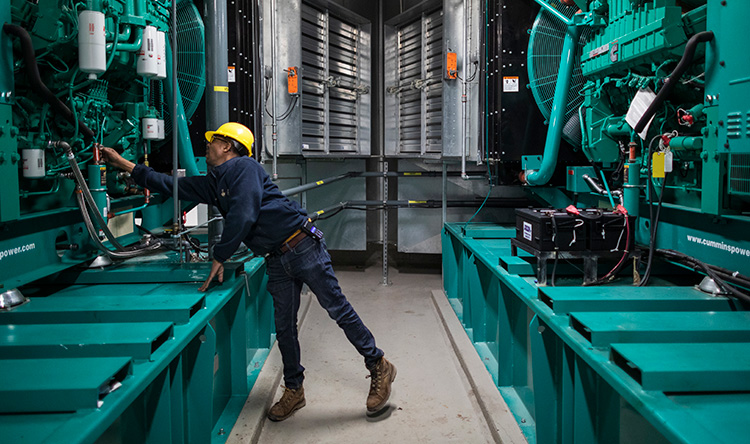Emergency generator testing

Facilities & Services has a robust program in place to maintain the emergency generators on the St. George campus.
The goals of generator testing are:
- To ensure that our electrical systems meet safety standards.
- To minimize the impact of disruptive power outages for our community.
Background
Power outages on campus could have many impacts for faculty, staff, and students, such as interruption to teaching and operations, loss of data, damage to critical equipment and systems, and irreversible harm to important research.
To minimize the impact of a loss of power, U of T relies on generators to provide emergency, backup, and/or standby power in the case of a power outage.
The generators ensure that building occupants, systems, and research are safe until the power outage ends and normal power is restored.
How emergency generators are used
Emergency generators are used for life-safety functions that are essential for safety to human life. Emergency generators can also be used for non-life-safety functions.
The function of each emergency generator depends on the role of the building the generator serves. For example, the emergency generator for a residence is used for life-safety functions. In the case of a power outage, this generator creates power to light its emergency lighting system, allowing people to exit safely.
In the case of a building with research laboratories, the emergency generator is used for life-safety and non-life-safety functions. If the power goes out, this creates power for its emergency lighting system and to prevent damage to critical research that can’t withstandpower interruptions.
F&S inspects, tests, and performs regular maintenance on emergency generators
Emergency generators require regular inspections and testing to ensure they are ready to supply power in the case of an outage.
The F&S Electrical Utilities team oversees the inspection, testing, and maintenance of 31 emergency generators. In line with the Canadian Standards Association, the F&S team and partner contractors conduct weekly inspections as well as monthly, semi-annual, annual, and five-year tests on the emergency generators. The team also proactively fixes the generators when needs are identified during inspections and tests.
Testing ensures that emergency generators will react as designed during a power outage to provide maximum reliability to the critical loads they serve. F&S tests the generators at 100% capacity each year to ensure their continued ability to respond to the growing demands on electrical infrastructure to support the University’s evolving needs.
Minimizing impact on building occupants
We take a variety of measures to ensure that service disruption associated with testing is minimal, including providing timely notices, conducting the longest and most in depth testing off-season, and minimizing the time that any equipment is disconnected from the emergency generator.
F&S carefully plans, schedules, and notifies our campus partners via service alerts about monthly and annual emergency generator tests to minimize the impact on operations, research, teaching, and other campus activities. The service alerts provide subscribers with information on timelines, location, and specific impact of each planned test.
During the monthly test, a power outage is artificially simulated, and the loads are transferred to the emergency generator. This results in a brief power outage of up to 15 seconds while the generator starts up and becomes ready to accept the load. This test may be noticed by occupants as it will cause lights to flicker or cause IT/research equipment to record the loss of power.
During the annual test, the emergency generator is connected to external resistors to have the generator run at 100% designed capacity for up to two hours. This is to prove the generator is fully capable of meeting its design criteria in the event of a real emergency.
The annual test is typically conducted during the summer when campus is less busy. Occupants near the generator may also feel the vibration of the generator running or see the exhaust system in operation.
The semi-annual and five-year tests are scheduled to take place at the same time as the monthly and annual tests, respectively, to maximize efficiency and minimize the number of tests conducted. During the semi-annual and five-year test, additional steps are performed such as changing the coolant and testing the generator windings.
Our regular inspection, testing, and maintenance is critical to maintain a reliable and safe environment for members of the U of T community.
